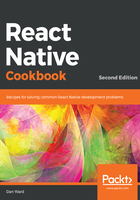
Conventions used
There are a number of text conventions used throughout this book.
CodeInText: Indicates code words in text, database table names, folder names, filenames, file extensions, pathnames, dummy URLs, user input, and Twitter handles. Here is an example: "We'll use a state object with a liked Boolean property for this purpose."
A block of code is set as follows:
export default class App extends React.Component {
state = {
liked: false,
};
handleButtonPress = () => {
// We'll define the content on step 6
}
When we wish to draw your attention to a particular part of a code block, the relevant lines or items are set in bold:
onst styles = StyleSheet.create({
container: {
flex: 1,
},
topSection: {
flexGrow: 3,
backgroundColor: '#5BC2C1',
alignItems: 'center',
},
Any command-line input or output is written as follows:
expo init project-name
Bold: Indicates a new term, an important word, or words that you see onscreen. For example, words in menus or dialog boxes appear in the text like this. Here is an example: "Click the Components tab, and install a simulator from the list of provided simulators."